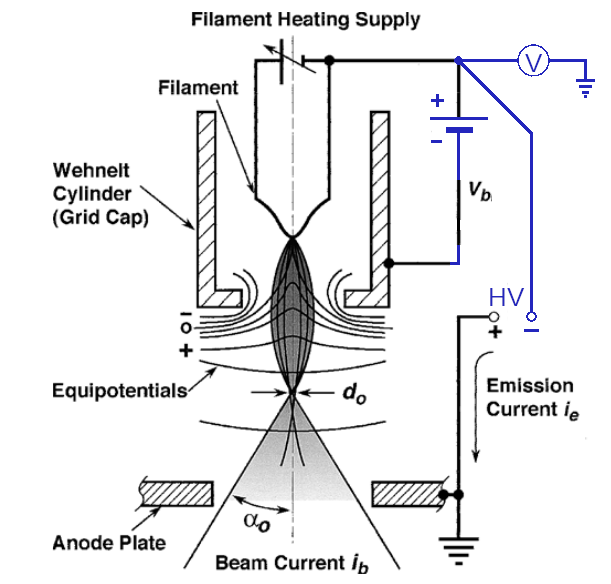Recently I just came across something so obvious and big (The really big Elephant in the room) that we could absolutely missed it in these attempts of precise DH estimation.
Let me quote a paragraph from Ritchie et al 2020 (Proposed practices for validating the performance of instruments used for automated inorganic gunshot residue analysis
https://doi.org/10.1016/j.forc.2020.100252), section on Duane-Hunt limit difference (4.1.3. Diagnosis), at point 1e we see this (emphasis is mine):
(c) The beam energy on some tungsten-filament SEMs is always a few hundred volts less than the set voltage due to a bias on the Wehnelt, a component of the electron gun assembly. A Duane-Hunt limit that is consistently low by a few hundred volts is not a problem so long as the over-voltage, U, on the lead L-lines is sufficient that they remain visible ( U > 1.5 20 keV/13.0 keV ).
While context about Pb L-lines is not relevant for us here, what is relevant is bias on the Wehnelt. First of all Bias voltage can be not just few hundred of volts but up to over one thousand! Let me show some quick summary of bias provided by different commercial HV supplies (SEM/EPMA dedicated) (aggregated from publicly available datasheets from manufacturer sites):
| Manufacturer; model(s) | | Max bias (kV) |
| Matsusada; SEM-30 & SEM-15 | 3.5 kV |
| CPS; 3604 & 3603 | 2kV |
| SpellmanHV, EBM20N5/24 | 1.5kV (alt 2 kV) |
| SpellmanHV, EBM-TEG | 3.5 kV |
| SpellmanHV, EBM-TEGR | 1.65 kV |
Operational bias depends a lot from geometry of W-hairpin and Wehnelt aperture assembly (i.e. diameter of aperture, thickness of W wire). In case of small Wehnelt aperture and close proximity to the W-wire, the bias voltage for proper operation will need to be small, where setting too huge bias would "pinch-off" the emission (it is over-generalization, and "pinch-off" is possible on some of designs and impossible on other. See below). On the other hand, if Wehnelt aperture is large, then 3kV of bias voltage could be just barely enough to get a beam crossover. All geometry/bias voltage approaches have it's pros and cons. But what matters for us here is actually how bias and acceleration voltage is regulated and I think it can be summarized in 3 possible types. The main emphasis there is how bias voltage difference is created, and where high voltage feedback is measured for regulation.
1. Classical

Pros: most simple
Cons: Voltage set and regulated on Wehnelt, voltage cathode (thus electron acceleration voltage, thus landing energy) always lower than set voltage.
Characteristics: fixed stable voltage, Bias voltage is regulated by regulating the resistance of bias resistor. 2 power transformers (heat, tension). Bias voltage is affected by emission current thus it has a minimal emission current limit thus which is not possible to go below and to pinch-off the emission.
2. Classical-alternative

Pros: still simple; Voltage is set and regulated on cathode
Cons: stability?
Characteristics: Bias is regulated by changing Resistance of Bias resistor, HV increases to compensate the voltage drop on the cathode, some limited possibilities for oscillations. 2 power transformers (heat, high tension). It has a minimal emission limit thus it is not possible to go below and pinch-off the emission.
3. Active Bias supply

Pros: Voltage of cathode is regulated independently from bias, It is possible to get smaller emission areas which would be not possible with resistive bias.
Cons: more complex built (3 power transformers instead of 2)
Characteristics: Bias is regulated independently from cathode voltage, bias is independent from emission - no self oscillation possible. It is possible to set bias voltage huge enough to "pinch-off" emission.
So Those SEM (and EPMA) which are affected by e) in quote from Ritchy'ies publication are some older generation instruments with type 1. HV supply.
At first glance Cameca SX100 HV tank is implemented like type 1. However it is not so very bad as cathode voltage can be calibrated for particular emission current, or tabulated and applied as corrections for different emission currents. Single potentiometer calibration in this case can help only temporary with single emission current, running with other emission currents than HV got calibrated with will provide some offset in read HV values from the tank. (I guess that is 100uA). The question is also if Cameca firmware does not do corrections behind the back (maybe thats why few year ago when set 15kV it was reporting 14.88kV?), and if Probe Software does not ignore that. Are Probe Software saving "setted" or "getted" HV values? or both? Which one is used in calculations?
Are someone familiar with HV system on Jeol (W-based) Probe? Could anyone comment which type it is?
I will soon share some DH limit experiments from our SXFiveFE. FE advantage is that it is more like type 3, thus I suspect the landing energy should be very close to the set voltage.